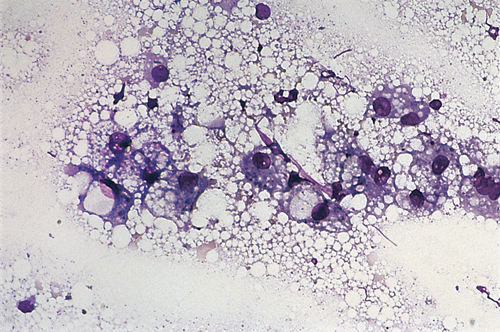Difference between revisions of "Cytology Q&A 06"
| (3 intermediate revisions by 2 users not shown) | |||
| Line 1: | Line 1: | ||
| − | {{Template:Manson}} | + | {{Template:Manson |
| + | |book = Cytology Q&A}} | ||
| − | [[Image:|centre|500px]] | + | [[Image:Cytology 06a.jpg|centre|500px]] |
<br /> | <br /> | ||
| − | '''A six-year-old female spayed DSH cat presented for chronic weight loss and a recent history of vomiting and severe lethargy. Physical examination revealed pale, icteric mucous membranes. The temperature was 38°C (100.4°F) and pulse and respiration rates were slightly increased. Abdominal palpation and radiographs revealed diffuse hepatomegaly. Examination of a peripheral blood smear indicated RBC shape abnormalities including severe acanthocytosis. Abnormal biochemistry values were: AST = 150 U/l (ref. = 2–36 U/l); ALT = 350 U/l (ref. = 6–80 U/l); ALP = 135 U/l (ref. = 2–43 U/l); bilirubin = 68 μmol/l (ref. = 0–3.4 μmol/l). An FNA of the liver was obtained and a smear made | + | '''A six-year-old female spayed DSH cat presented for chronic weight loss and a recent history of vomiting and severe lethargy. Physical examination revealed pale, icteric mucous membranes. The temperature was 38°C (100.4°F) and pulse and respiration rates were slightly increased. Abdominal palpation and radiographs revealed diffuse hepatomegaly. Examination of a peripheral blood smear indicated RBC shape abnormalities including severe acanthocytosis. Abnormal biochemistry values were: AST = 150 U/l (ref. = 2–36 U/l); ALT = 350 U/l (ref. = 6–80 U/l); ALP = 135 U/l (ref. = 2–43 U/l); bilirubin = 68 μmol/l (ref. = 0–3.4 μmol/l). An FNA of the liver was obtained and a smear made (Wright–Giemsa, ×25).''' |
<br /> | <br /> | ||
| Line 37: | Line 38: | ||
Because these cats are already ill and stressed, extreme care must be taken not to cause further stress by force-feeding.<br><br> | Because these cats are already ill and stressed, extreme care must be taken not to cause further stress by force-feeding.<br><br> | ||
Note: An additional photomicrograph is included here for comparison (29b) (Wright–Giemsa, ×100 oil). The multiple small, crisply defined cytoplasmic vacuoles within hepatocytes are characteristic of this condition. | Note: An additional photomicrograph is included here for comparison (29b) (Wright–Giemsa, ×100 oil). The multiple small, crisply defined cytoplasmic vacuoles within hepatocytes are characteristic of this condition. | ||
| − | |l3=Hepatic Lipidosis | + | |l3=Hepatic Lipidosis#Treatment |
</FlashCard> | </FlashCard> | ||
Latest revision as of 15:58, 23 September 2011
| This question was provided by Manson Publishing as part of the OVAL Project. See more Cytology Q&A. |
A six-year-old female spayed DSH cat presented for chronic weight loss and a recent history of vomiting and severe lethargy. Physical examination revealed pale, icteric mucous membranes. The temperature was 38°C (100.4°F) and pulse and respiration rates were slightly increased. Abdominal palpation and radiographs revealed diffuse hepatomegaly. Examination of a peripheral blood smear indicated RBC shape abnormalities including severe acanthocytosis. Abnormal biochemistry values were: AST = 150 U/l (ref. = 2–36 U/l); ALT = 350 U/l (ref. = 6–80 U/l); ALP = 135 U/l (ref. = 2–43 U/l); bilirubin = 68 μmol/l (ref. = 0–3.4 μmol/l). An FNA of the liver was obtained and a smear made (Wright–Giemsa, ×25).
| Question | Answer | Article | |
| Explain the abnormal RBC shape and the biochemistry abnormalities. | Acanthocytes are spherical erythrocytes with blunt tipped spicules of different lengths projecting from the surface at irregular intervals.
|
Link to Article | |
| Describe the cytological findings, and give your cytological interpretation. |
|
Link to Article | |
| List the differentials for your diagnosis, and discuss treatment options. | Hepatic lipidosis in cats may be a primary disease or may occur secondary to other metabolic, inflammatory or neoplastic conditions. Approximately 50% of cases are idiopathic. Differentials for secondary hepatic lipidosis include
The key to successful management of cats with lipidosis, as seen in this case, is early diagnosis and intensive nutritional support. Cats typically require nutritional support for 3–6 weeks with high-protein, calorie-dense food, usually via PEG tubes. |
Link to Article | |
